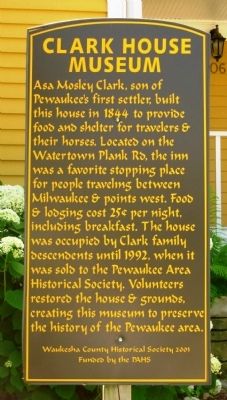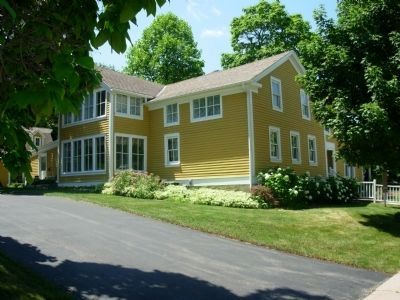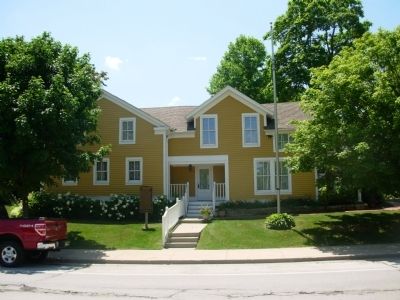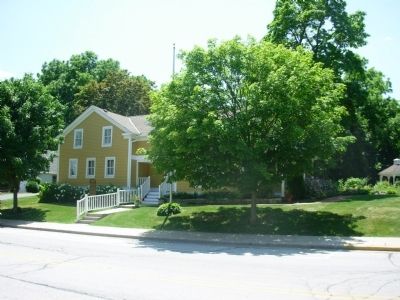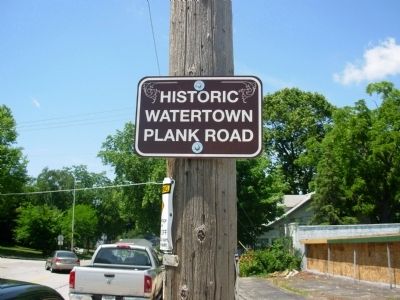Pewaukee in Waukesha County, Wisconsin — The American Midwest (Great Lakes)
Clark House Museum
Erected 2003 by Waukesha County Historical Society, Funded by PAHS. (Marker Number 26-01.)
Topics. This historical marker is listed in this topic list: Settlements & Settlers. A significant historical year for this entry is 1844.
Location. 43° 4.852′ N, 88° 15.607′ W. Marker is in Pewaukee, Wisconsin, in Waukesha County. Marker is at the intersection of East Wisconsin Avenue (County Road M) and Prospect Avenue (County Road G), on the right when traveling east on East Wisconsin Avenue. Touch for map. Marker is at or near this postal address: 206 E Wisconsin Ave, Pewaukee WI 53072, United States of America. Touch for directions.
Other nearby markers. At least 8 other markers are within 5 miles of this marker, measured as the crow flies. Pewaukee Village (approx. 0.4 miles away); Hon. Thomas Weaver Home (approx. 2.9 miles away); Waukesha Beach Amusement Park (approx. 2.9 miles away); Halquist Quarry (approx. 3.1 miles away); George Washington Burr Oak (approx. 3.9 miles away); Sussex Mills and Bug Line RR (approx. 4 miles away); First Woman in Town of Lisbon (approx. 4.1 miles away); St. Alban’s Episcopal Church (approx. 4.2 miles away). Touch for a list and map of all markers in Pewaukee.
Additional commentary.
1. History of Clark House
Asa Clark was the first white settler in Pewaukee, arriving in 1837. He made the trip with a neighbor on horseback from Vermont to Milwaukee. There he met with Childs and Wheelock to form a partnership in order to build a mill on Snail Lake in Pewaukee (Pewaukee Lake today).
Asa's son, Mosely, built a house for the family in 1844 which later bacame a stagecoach stop and hotel. The house was double-gabled with a front L-shaped porch. Because of the beautiful lilac bushes surrounding the house, it was referred to as Lilac Rest.
When the Watertown Plank Road was built, Asa's house happened to be sitting right on it. Many travelers from Milwaukee to Watertown were using the plank road.
Since that was a long distance by horse-drawn stagecoach, hotels were needed along the way to stop for the night. The Mosely Clark Stagecoach Inn charged 25 cents a night including breakfast. The food they served came from the Mill and a nearby farm. Sometimes as many as 60 people stayed there. If there were more people than that, they could stay in the barn across the street. The beds were rope-spring type with straw-filled mattresses. As more hotels were built in Pewaukee, the Mosely Clark Stagecoach Inn went back to being the home of Mosely and Sarah Clark and their family. The house had remained in the family until 1984 when the Pewaukee Historical Society purchased it for their museum.
Today the museum includes the house and grounds and a large barn-type building in the back all displaying Pewaukee history from Native American days, to the first white settlers, to the days of Waukesha Beach and beyond. The museum is open seasonally from late May until late October on Sunday afternoons and Wednesday evenings. Note To Editor only visible by Contributor and editor
— Submitted July 15, 2011, by Linda Hansen of Waukesha, Wisconsin.
Credits. This page was last revised on October 16, 2020. It was originally submitted on July 12, 2011, by Paul Fehrenbach of Germantown, Wisconsin. This page has been viewed 1,160 times since then and 46 times this year. Photos: 1, 2, 3, 4, 5. submitted on July 12, 2011, by Paul Fehrenbach of Germantown, Wisconsin. • Bernard Fisher was the editor who published this page.
